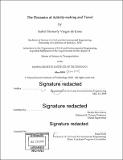| dc.contributor.advisor | Moshe Ben-Akiva. | en_US |
| dc.contributor.author | Hemerly Viegas de Lima, Isabel | en_US |
| dc.contributor.other | Massachusetts Institute of Technology. Department of Civil and Environmental Engineering. | en_US |
| dc.date.accessioned | 2018-11-28T15:43:38Z | |
| dc.date.available | 2018-11-28T15:43:38Z | |
| dc.date.copyright | 2018 | en_US |
| dc.date.issued | 2018 | en_US |
| dc.identifier.uri | http://hdl.handle.net/1721.1/119333 | |
| dc.description | Thesis: S.M. in Transportation, Massachusetts Institute of Technology, Department of Civil and Environmental Engineering, 2018. | en_US |
| dc.description | Cataloged from PDF version of thesis. | en_US |
| dc.description | Includes bibliographical references (pages 75-80). | en_US |
| dc.description.abstract | Transportation modeling has played a key role in how decision makers and planners make decisions for transport networks and cities. With the increase in available technology, the complexity of the designed interventions is growing. To complement and inform these decisions, transportation models must develop to reflect the multidimensional scope of the impact of such interventions and the individualized responses to them. While travel has traditionally been considered a means to reach activities, the understanding of why people perform an activity is still very limited. This thesis presents an overview of activity- and agent-based transportation demand models, and argues that activity-making in these models can be improved by explicitly measuring and modelling the happiness derived from these activities. It also proposes a Dynamic Activity-making Model-and a modified version that includes happiness measures-to capture the dynamic nature of activity-planning and actuation. To explore measuring happiness, the thesis includes a chapter on a study conducted in Melbourne, Australia. Users were asked twice daily to report on happiness for a single activity, including travel. Based on the collected data, the chapter develops a dynamic Ordinal Logit Model for measuring happiness and discusses the estimation results in the context of Hedonic Theory. The results show how different activity types (work, education, personal, discretionary, travel, staying at home, and other) affect individuals' experienced happiness. It finds that educational activities, followed by work and travel, are the most disliked. Discretionary actives-which include social activities, meals, recreation, etc.-and other activities are seen to lead to more positive experiences of happiness. The model is used to test for the presence of an intra-activity Hedonic Treadmill Effect. It is found that people remember their activities as more neutral in later reports of happiness. The implications for the measurement of happiness data are discussed. In the following chapter, the thesis presents current efforts in the field to make agent-based modelling more dynamic and responsive to changes within a day, and presents a modelling framework to do so based on Latent Plan Models. The Dynamic Activity-making Model has a number of advantages, namely its ability to explicitly model changes in plans, to capture the utility of a day, and to eliminate the recursive integration with a supply module, such as dynamic traffic assignment. Finally, the chapter introduces a potential framework for including one's state of happiness into the Dynamic Activity-making Model. | en_US |
| dc.description.statementofresponsibility | by Isabel Hemerly Viegas de Lima. | en_US |
| dc.format.extent | 80 pages | en_US |
| dc.language.iso | eng | en_US |
| dc.publisher | Massachusetts Institute of Technology | en_US |
| dc.rights | MIT theses are protected by copyright. They may be viewed, downloaded, or printed from this source but further reproduction or distribution in any format is prohibited without written permission. | en_US |
| dc.rights.uri | http://dspace.mit.edu/handle/1721.1/7582 | en_US |
| dc.subject | Civil and Environmental Engineering. | en_US |
| dc.title | The dynamics of activity-making and travel | en_US |
| dc.type | Thesis | en_US |
| dc.description.degree | S.M. in Transportation | en_US |
| dc.contributor.department | Massachusetts Institute of Technology. Department of Civil and Environmental Engineering | |
| dc.identifier.oclc | 1065523759 | en_US |
